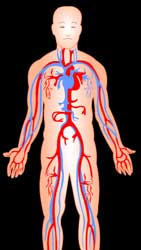 The
cardiovascular or circulatory system is responsible for the movement
of blood throughout the body, with the purpose of delivering oxygen
and nutrients to tissues, disposing waste products from the tissues
plus carrying hormones as cellular signals. The
cardiovascular or circulatory system is responsible for the movement
of blood throughout the body, with the purpose of delivering oxygen
and nutrients to tissues, disposing waste products from the tissues
plus carrying hormones as cellular signals.
It consists of a pump (the heart) and an
extensive network of channels (the arteries, capillaries and veins).
The arteries carry blood away from the heart; the capillaries allow
for exchange of material between the blood and the tissues; the
veins return the blood to the heart. In addition to blood vessels, a
second network of channels, the lymphatic vessels, will also be
studied in this exercise. These vessels carry lymph
(intercellular fluid) which is filtered through lymph nodes and
eventually returned back to the blood.
Learning Objectives:
- Understand that the circulatory
system comprises the heart, blood vessels, and lymphatic vessels.
- Understand that the walls of the
heart are composed of three complex layers, endocardium,
myocardium, and epicardium, which are all different histologically.
- Know the histological features of
arteries and veins as found within three layers: tunica intima,
tunica media, and tunica adventitia.
- Understand that both arteries and
veins are classified primarily according to the cellular and the
extracellular components of the adventitia and media and also
according to size.
- Understand that capillaries are
described as continuous, fenestrated, or discontinuous depending
on their structure and function, that capillary beds are the sites
for the formation of lymph, and that arteriovenous anastomoses (AV
shunts) enable blood to bypass capillaries.
- Know the histological organization
of lymphatic capillaries and larger lymphatic vessels, their
relationship to lymph nodes, and how they differ from blood
vessels.
Let's first look at
the heart. |